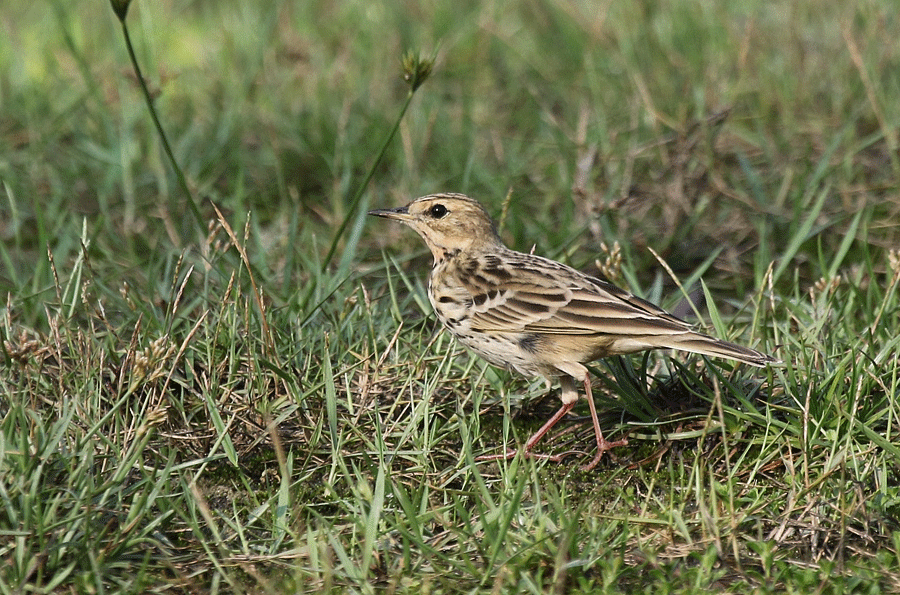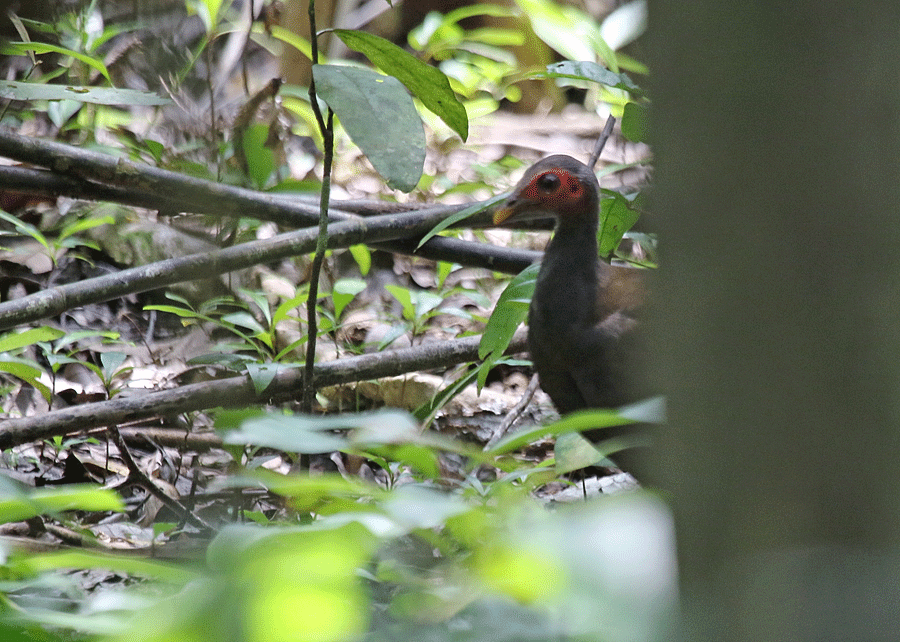Today was principally memorable for a good amount of ‘vis mig’ (visible migration) which peaked in mid-morning. Most of this was made up of raptors (1 Oriental Honey-Buzzard, 11 Grey-faced Buzzards, 3 Chinese Sparrowhawks and 17 Japanese Sparrowhawks, but it also included small numbers of Red-rumped Swallows, Pacific Swifts and, more noteworthy, single overflying Black-naped Oriole and Ashy Minivet, both mega-rarities in Borneo. There also seemed to be a fresh arrival of flycatchers, with 1 Asian Brown, 8 Grey-streaked, 13 Blue-and-White, 3 Narcissus and 1 Taiga (the latter a lingering bird). There were reasonable numbers of Arctic Warblers too, with a single Japanese Leaf Warbler, and some of the longer-staying migrants like Brown Shrike and Chestnut-cheeked Starlings.

As soon as I left the house at daybreak I noticed this Grey-streaked Flycatcher on the washing line! A hopeful sign?
I started the morning at the football field, and decided to try to get better shots of some of the long-staying birds. Once I located them, I crept up and spent over an hour in close proximity to the group – very nice!

This juv Yellow Bittern had been around since Day 1, but now seemed rather weak. I discovered it had a wound on one wing and was reluctant to fly.

The two juvenile Pacific Golden Plovers seemed to quickly get used to my presence.

The three Little Ringed Plovers even more so; they were happy to feed within a few feet of me.



Five Red-throated Pipits remained, and were more confiding than on previous days.

While photographing the pipits and waders, I noticed this Arctic Warbler foraging in a bush behind them!
Soon things started getting busy overhead, and I had my ‘hands full’ trying to record the raptors which rapidly appeared and then flew over.

A male Oriental Honey-Buzzard got things going

Grey-faced Buzzards arrived singly or in small groups, some accompanied by Chinese Sparrowhawks


Male (top) and female Chinese Sparrowhawks



Some of the Japanese Sparrowhawks. All appeared to be juvenile birds.


Red-rumped Swallows – once considered a great rarity in Borneo



A rather ragged Pacific Swift. The brown head is a good distinguishing feature from Cook’s. The rump patch does not look particularly large.


I tried getting some photos of the resident swiftlets. According to the literature, these are Germain’s, but I got the impression that these were longer-winged, with a more rakish outline and more powerful flight than the birds I see in the Peninsula. Subtle perhaps, but I’d like to learn more, especially now that another swiftlet sp has been found on Balambangan Island.
The oriole and the minivet occurred within a few moments of each other. I got poor photos of the oriole as it flew directly away from me. I heard the minivet first, and then saw it in flight distantly, but was not able to relocate either bird.
After lunch I went to the west end of the island, where I got poor photos of a Tabon Scrubfowl.

There were not many birds in the forest (and lots of mozzies!). However, I did manage to find one secretive bird there…

It took me a while to figure out what it was in the gloom; it eventually revealed itself to be a 1st calendar year male Narcissus Flycatcher, a new plumage for me!


An adult male and 1st calendar year female Narcissus Flycatcher were at the opposite end of the island.




There were lots of plumages of Blue-and-White Flycatcher on show today! At the top is an adult female, then a 1st year male, and two adult males at the bottom. The lower bird might be the ‘intermedia‘ race, as it seems to have quite a bit of blue in the throat and upper breast.

Two Blue-and-White Flycatchers!


For completeness, another Grey-streaked (top) and a Taiga Flycatcher

There were at least 5 Arctic Warblers. This one is typical – slightly yellowish supercilium, dusky spot at the tip of the lower mandible, etc.

But what about this one? Rather ‘colourless’ and it has a strikingly extensive dark tip to the lower mandible, something I’ve noticed on photographs of known Kamchatka Leaf Warblers, such as this one and this one, as well as on the illustration of the species by Ian Lewington in Rare Birds of North America. Unfortunately it didn’t call, so must only remain a ‘possible’.

Lastly, I thought it must be great to be on a fishing boat followed by frigatebirds rather than terns!

Nice record, Dave. Will extract for Sabah Rarity list. Thank you.
You can extract all the details from eBird Wong
Dave, are all the photos taken with your new combo set?
No Ronnie, Yann had left the day before, so all these were taken with the old lens.
What new sp. of Swiftlet found at Balambangan Island Dave?
Good question Azahari! Frank Rheindt et al. published a paper here: http://lkcnhm.nus.edu.sg/rbz/biblio/62/62rbz089-099.pdf in which they analysed muscle tissue of some skins which are housed in the US which were collected from Balambangan Island. The results showed that the birds belong to a taxon not yet on the Malaysian list. They class it as Aerodromus palawanensis (currently considered a race of Uniform Swiftlet (A. vanikorensis) by Clements, but proposed as ‘Ameline Swiftlet’ by the authors of the paper. Since no-one has yet seen a living example of the species in the field, the Records Committee have decided to wait for further developments before we add it to the Malaysian list (mostly because we don’t know what to call it!).